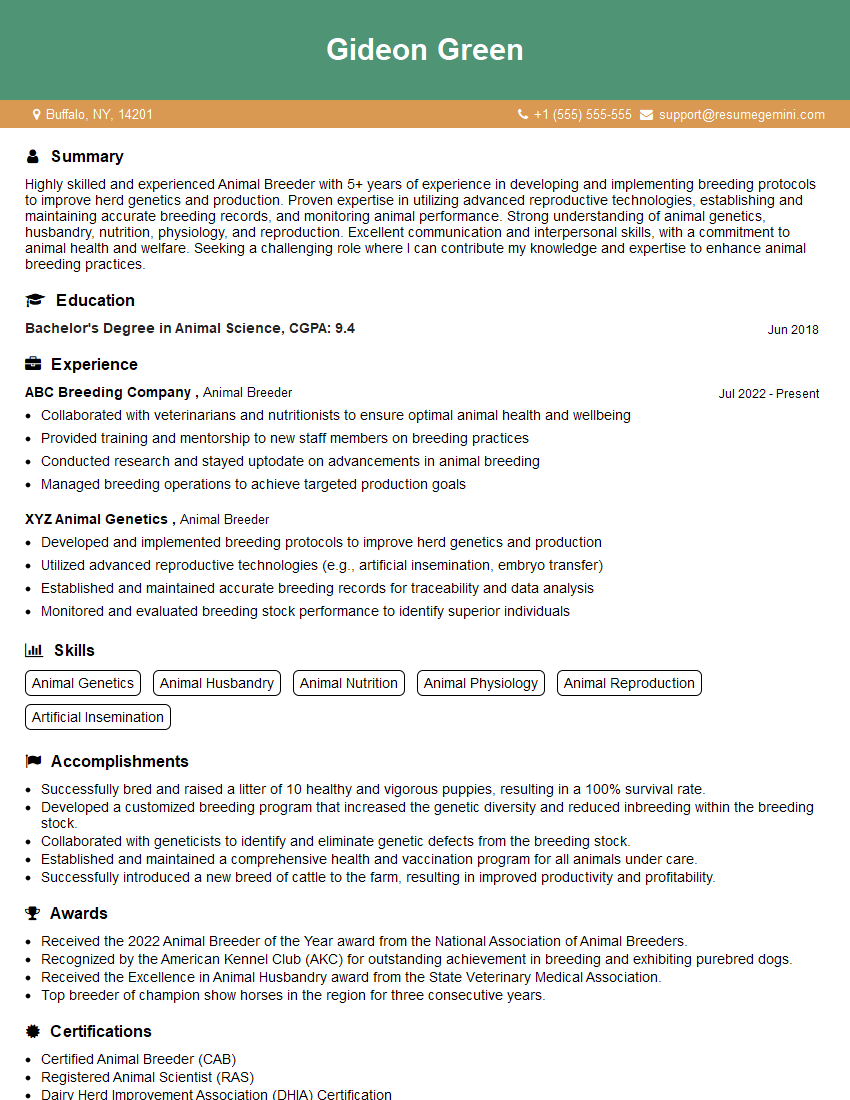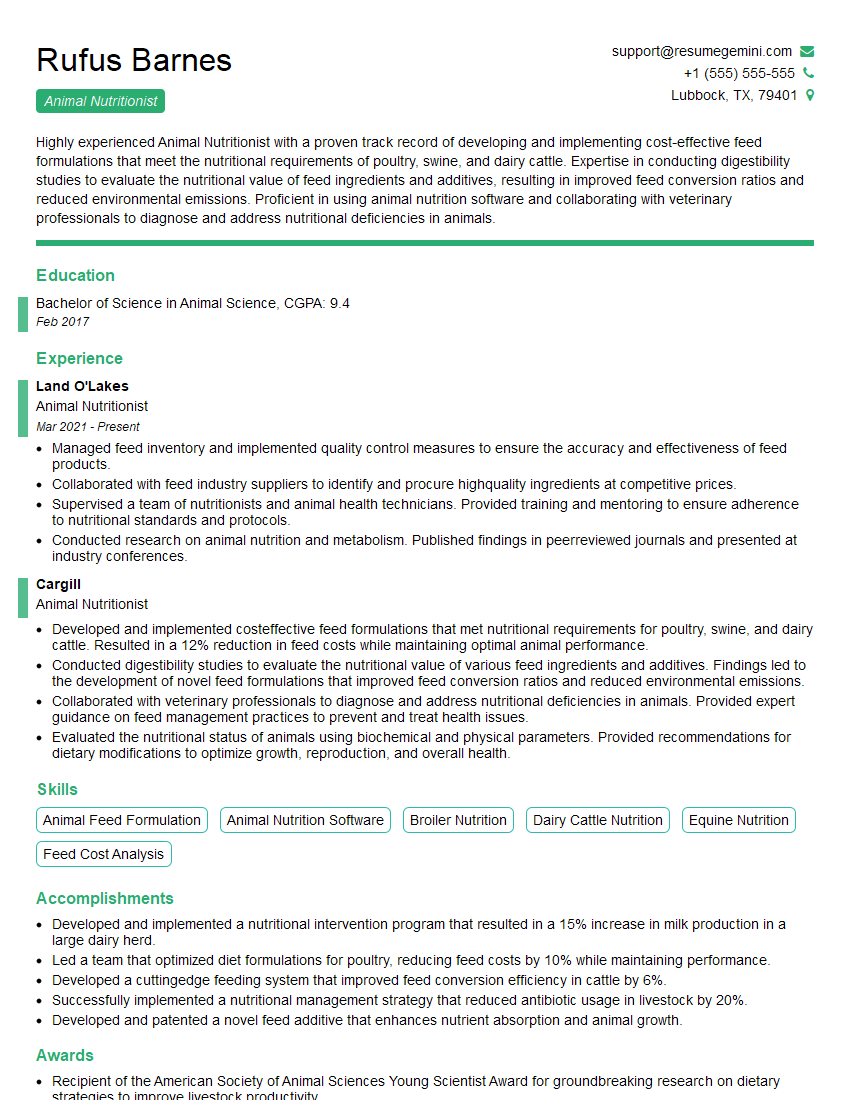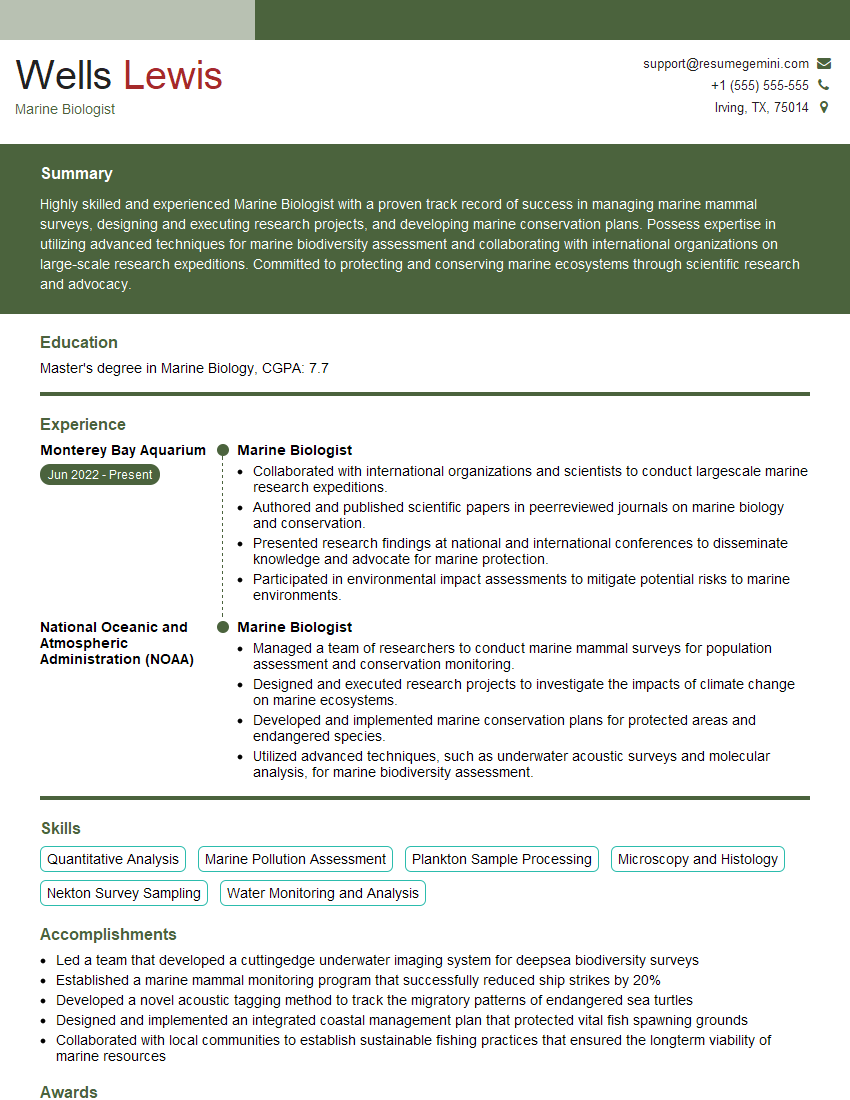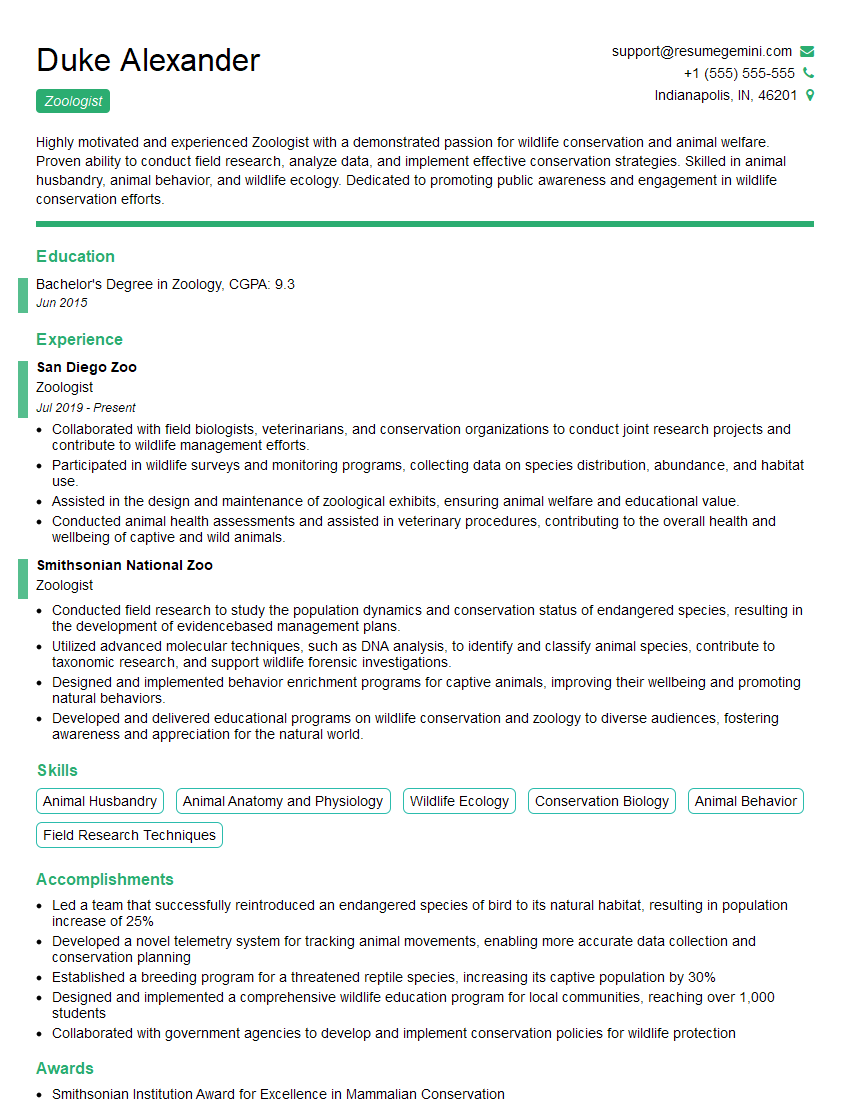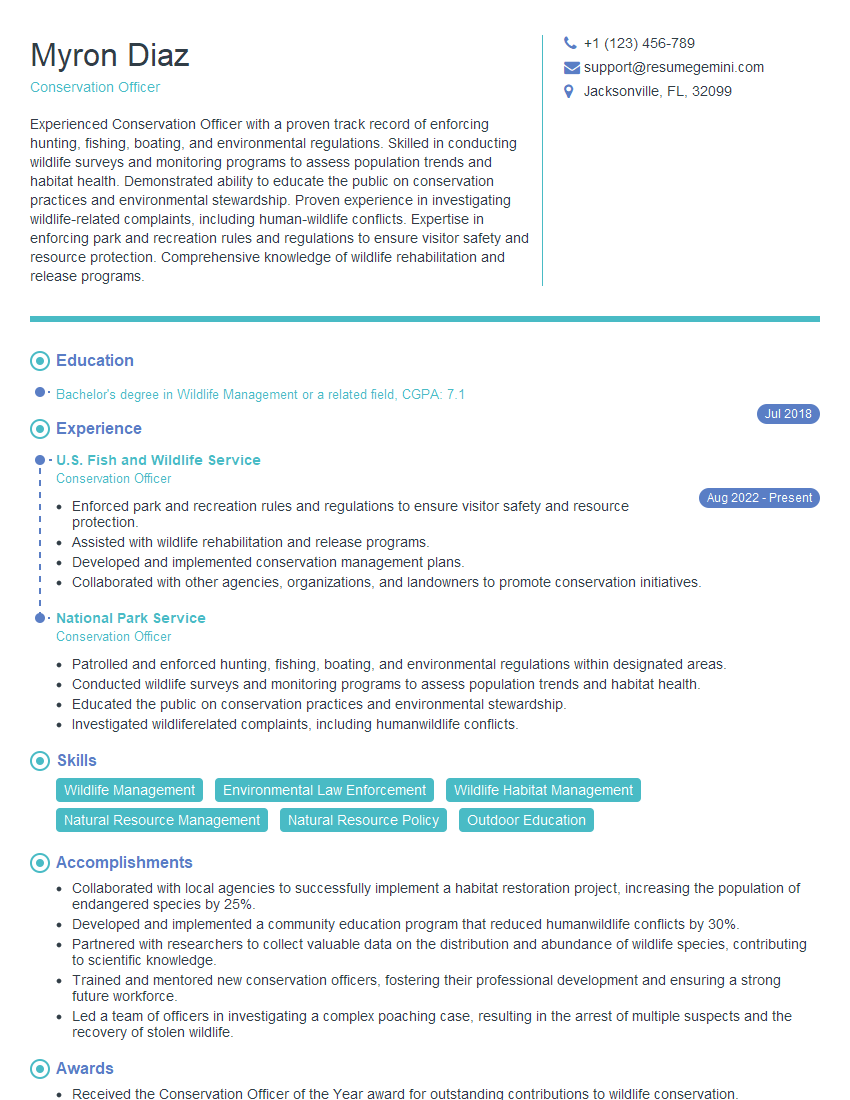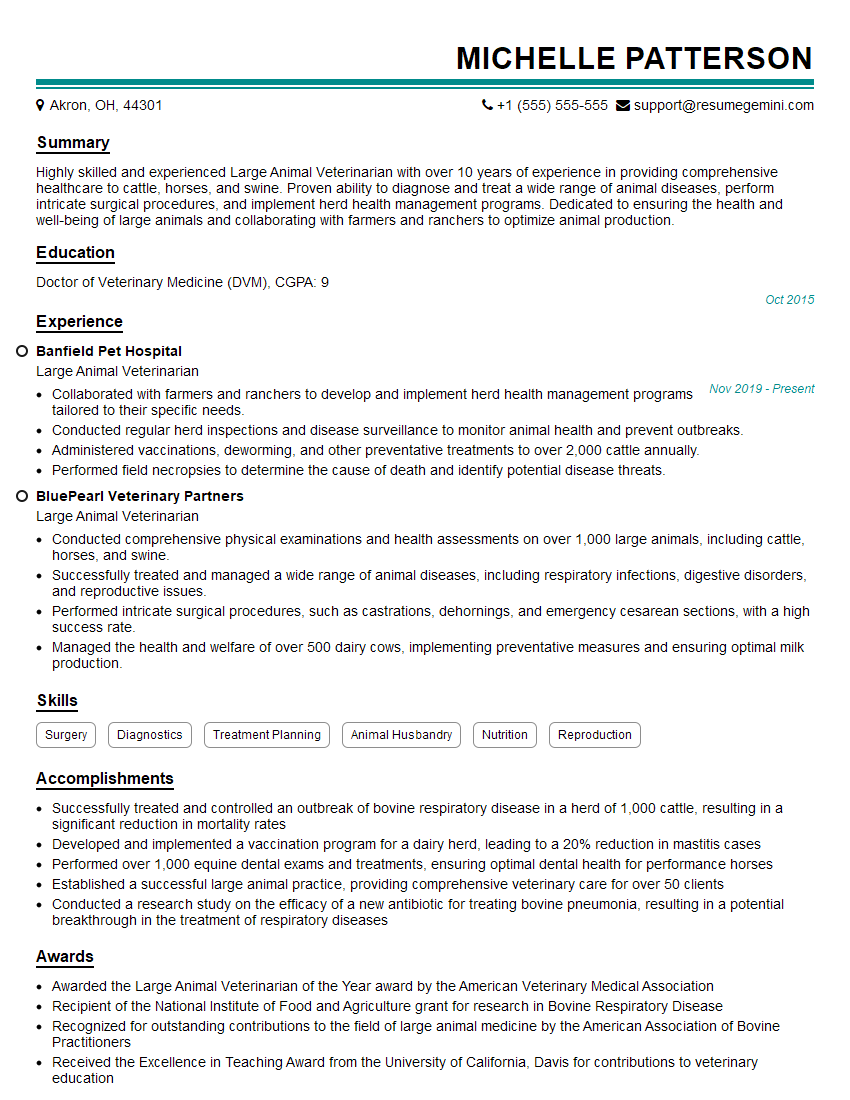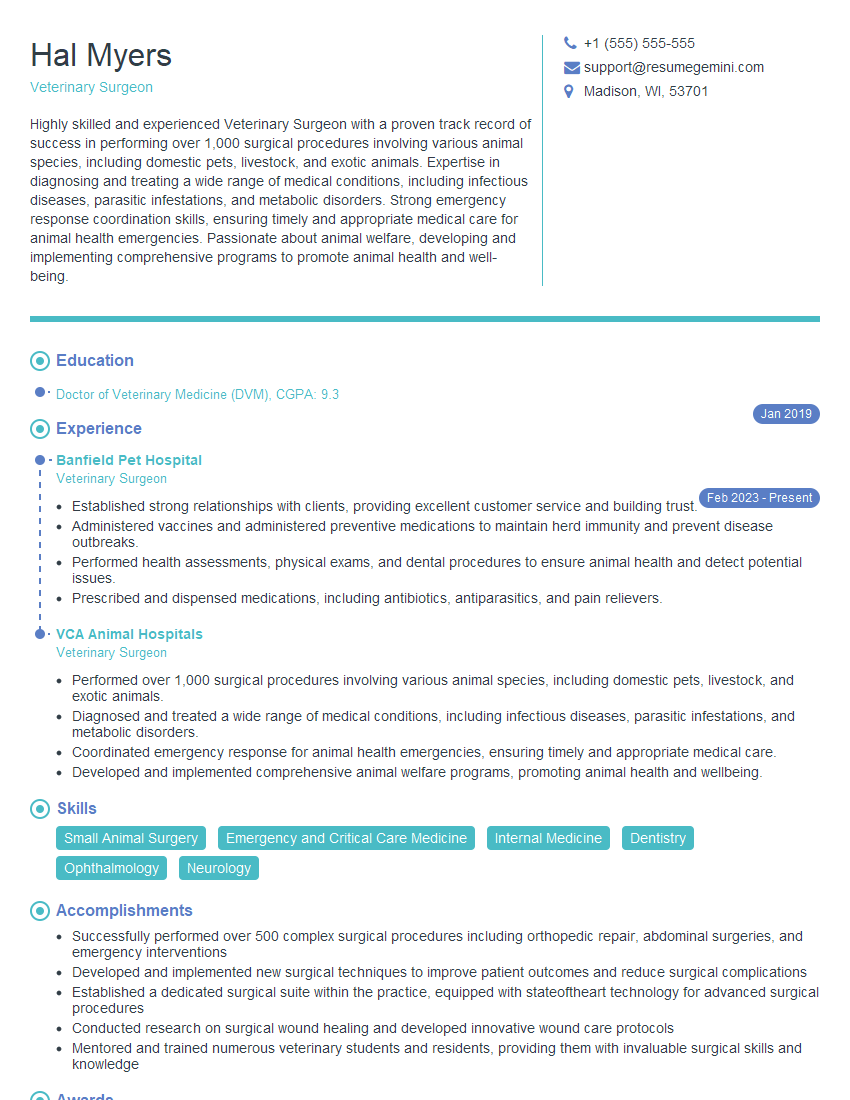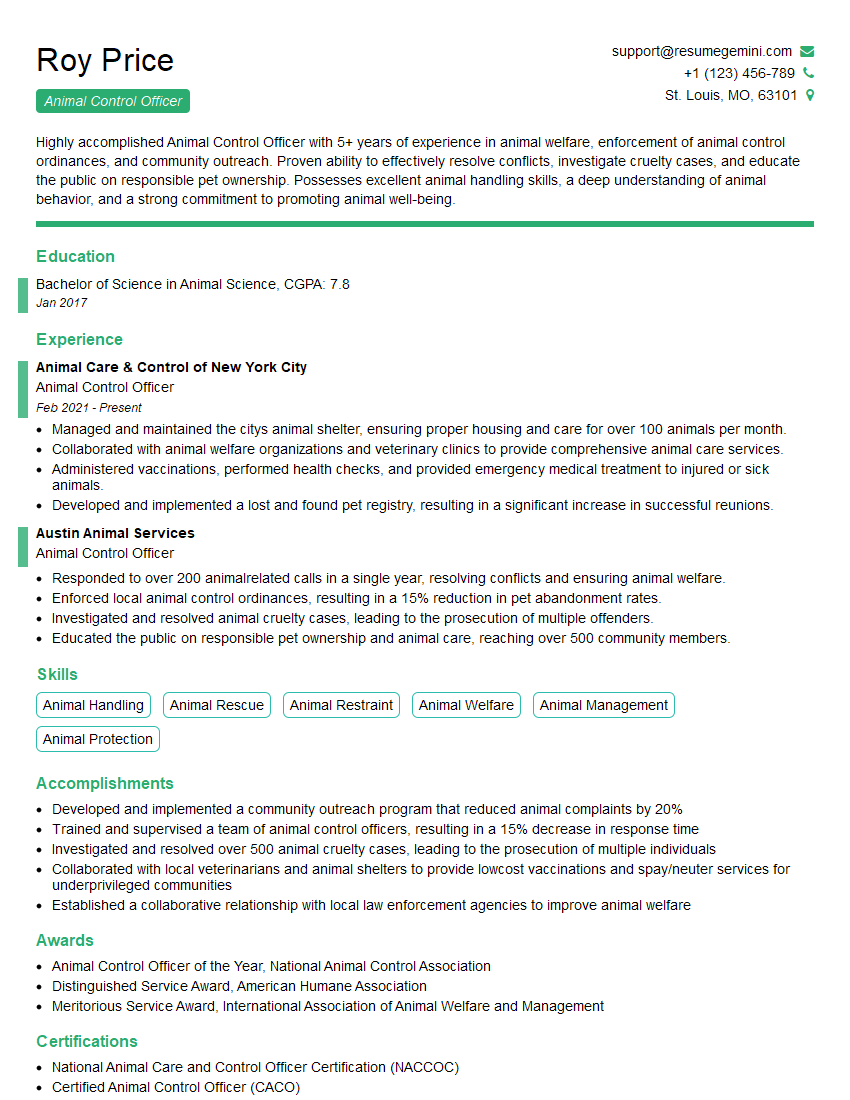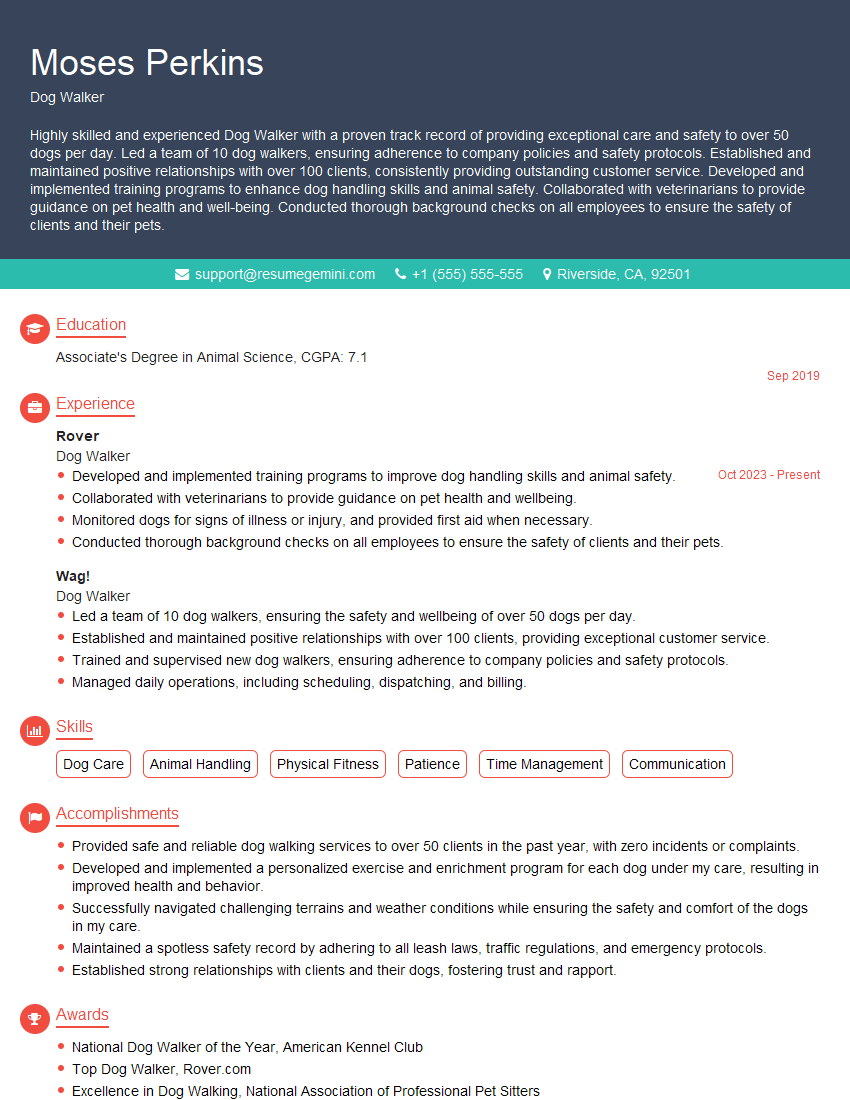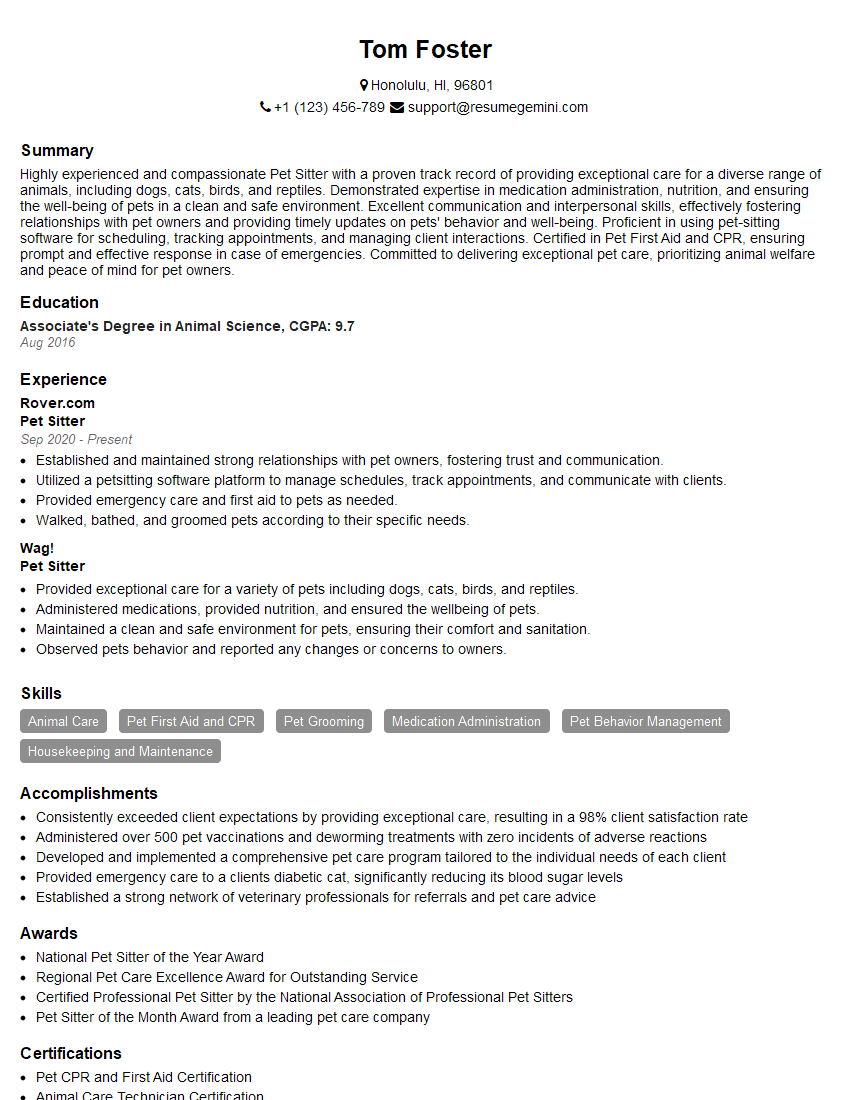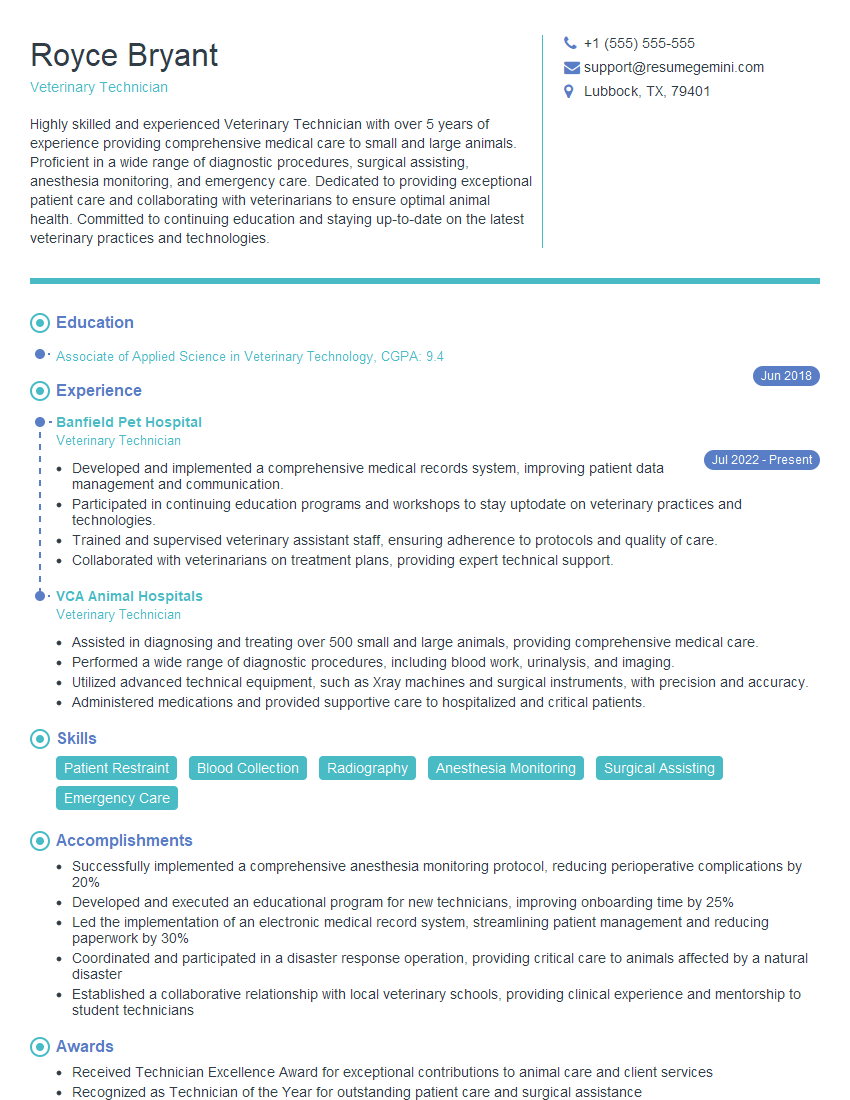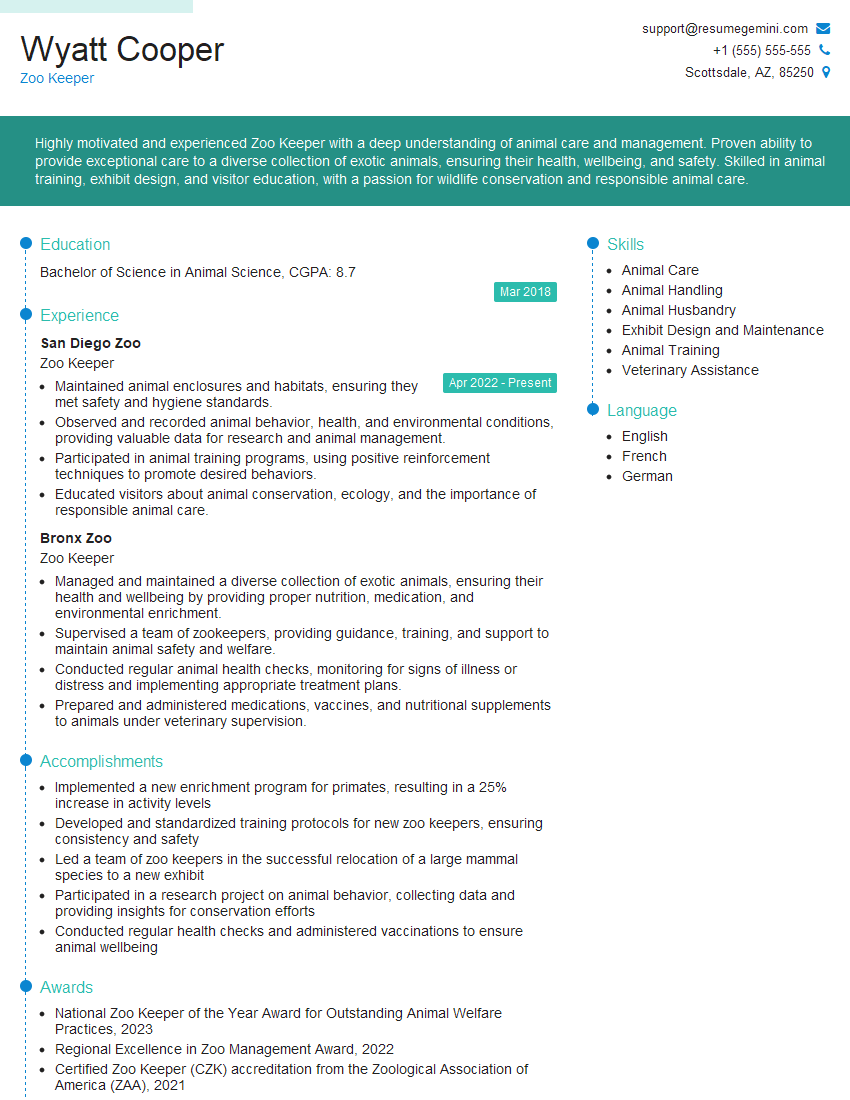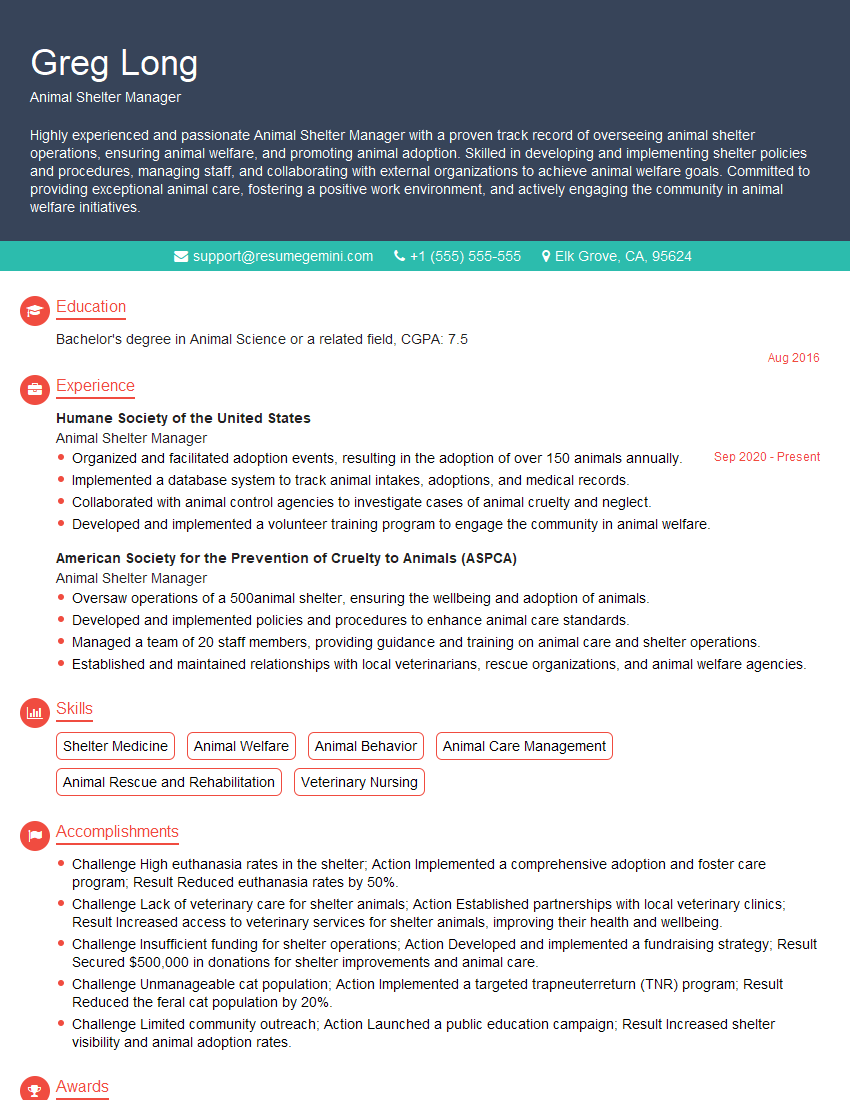Cracking a skill-specific interview, like one for Working with Animals, requires understanding the nuances of the role. In this blog, we present the questions you’re most likely to encounter, along with insights into how to answer them effectively. Let’s ensure you’re ready to make a strong impression.
Questions Asked in Working with Animals Interview
Q 1. Describe your experience with different animal breeds and species.
My experience spans a wide range of animal breeds and species, from common domestic pets like dogs (ranging from tiny Chihuahuas to giant Great Danes, and including various breeds with different temperaments and needs) and cats (Siamese, Persians, Maine Coons, etc., each with unique grooming requirements) to livestock animals such as horses (thoroughbreds, quarter horses, ponies, etc.), cattle, sheep, and goats. I’ve also worked with a variety of avian species, including parrots, chickens, and waterfowl, and even some exotic animals like reptiles and small mammals in controlled environments. This diverse experience has given me a deep understanding of the unique needs and characteristics of each species and breed.
For instance, working with horses required a different approach than working with cats. Understanding equine body language, herd dynamics, and their unique health concerns is crucial. Similarly, working with small, delicate birds necessitates gentle handling and specialized knowledge of their respiratory and digestive systems.
Q 2. Explain your approach to handling aggressive or fearful animals.
Handling aggressive or fearful animals requires a calm, patient, and understanding approach. My strategy focuses on building trust and minimizing stress. For aggressive animals, I prioritize safety – both mine and the animal’s. This often involves using appropriate protective equipment like thick gloves and muzzles (when safe and appropriate for the species). I use slow, deliberate movements to avoid startling the animal and observe its body language carefully to anticipate potential reactions.
With fearful animals, I focus on creating a safe and comfortable environment. This might involve using positive reinforcement techniques, such as offering treats or gentle petting, once the animal feels comfortable enough to interact. It’s about letting them dictate the pace of interaction, rewarding any positive behaviors, and ensuring that every interaction is positive to reduce fear and build confidence. In some cases, professional assistance from a veterinary behaviorist may be necessary.
Q 3. What are the signs of common animal illnesses or injuries?
Recognizing signs of illness or injury in animals requires careful observation. Common signs include:
- Changes in appetite or drinking habits (increased or decreased)
- Lethargy or unusual behavior (e.g., hiding, aggression)
- Respiratory distress (coughing, difficulty breathing)
- Diarrhea or vomiting
- Lameness or limping
- Changes in elimination habits (straining, infrequent urination)
- Fever (often detectable through touch in some animals)
- Visible wounds or injuries
- Weight loss or gain
- Changes in skin or coat condition (e.g., dullness, hair loss)
The specific signs will vary depending on the species and the underlying condition. Any unusual behavior or change in an animal’s normal state should be investigated by a veterinarian.
Q 4. How do you administer medication to animals?
Administering medication to animals requires careful attention to the specific medication, the route of administration (oral, topical, injection), and the species. Oral medication can be tricky, especially with animals who are resistant to taking pills. Different techniques, such as hiding medication in food or using pill pockets, can be employed. Topical medications are applied directly to the skin or affected area. Injections require precise technique and knowledge of anatomy to avoid injury.
For example, administering medication to a large dog might involve hiding a pill in a piece of meat or using a pill-popping device to place the pill further back in their mouth. Cats, on the other hand, might require a different approach, possibly involving a small amount of liquid medication added to their food. Injectable medications are always given under the supervision of a veterinarian or a trained professional because improper administration can lead to complications.
Q 5. Detail your experience with animal restraint techniques.
My experience encompasses a range of animal restraint techniques, always prioritizing the animal’s safety and well-being. The choice of technique depends on the animal’s species, size, temperament, and the reason for restraint. Gentle restraint, such as using a towel to wrap a small animal for a quick examination, is often sufficient. More forceful methods, such as using specialized equipment (like catch poles for large animals or nets for birds), are employed only when absolutely necessary and always with safety precautions.
It’s critical to remember that each animal is an individual, and the approach must be tailored to its specific needs. Understanding animal behavior is key; for example, knowing that cornering an animal can trigger a fight-or-flight response. Improper restraint can cause injury to both the animal and the handler. Safe handling procedures and appropriate equipment are crucial for both animal welfare and personal safety.
Q 6. Describe your knowledge of animal anatomy and physiology.
A strong understanding of animal anatomy and physiology is fundamental to my work. I’m familiar with the skeletal, muscular, circulatory, respiratory, digestive, and nervous systems of various species. This knowledge allows me to assess an animal’s condition effectively, recognize abnormalities, and understand the implications of diseases or injuries. For example, knowing the location of major blood vessels is crucial for safe injections. Understanding digestive processes helps in diagnosing gastrointestinal issues. Knowledge of musculoskeletal anatomy is essential for assessing lameness.
My knowledge goes beyond basic anatomy; I understand the functional interrelationships within these systems. How changes in one system can affect others, and how those changes manifest as observable symptoms. This holistic approach allows me to provide more informed and effective care.
Q 7. Explain your understanding of animal behavior and training principles.
My understanding of animal behavior and training principles is based on positive reinforcement and a thorough knowledge of species-specific communication methods. I believe in creating positive interactions to build trust and encourage desired behaviors. Positive reinforcement methods, such as rewarding good behavior with treats or praise, are far more effective than punishment-based methods, which can create fear and aggression.
I adapt my approach based on the individual animal’s personality and learning style. Consistency is key; animals respond best to clear and consistent communication and training protocols. I use a combination of classical and operant conditioning techniques to achieve desired outcomes. For example, classical conditioning can be used to associate a specific sound or gesture with a positive outcome (like a treat), while operant conditioning involves rewarding desired behaviors and ignoring or redirecting unwanted behaviors. This creates a positive and productive learning environment for the animal.
Q 8. How do you maintain a clean and sanitary environment for animals?
Maintaining a clean and sanitary environment for animals is paramount to their health and well-being. It involves a multi-faceted approach encompassing regular cleaning, disinfection, and pest control. Think of it like keeping a spotless home – only for your animal companions.
Regular Cleaning: This includes daily removal of feces, soiled bedding, and leftover food. Frequency varies depending on the species and the number of animals. For example, a rabbit hutch needs daily cleaning, whereas a large outdoor enclosure might require less frequent, but more thorough, cleaning.
Disinfection: Regular disinfection using appropriate veterinary-approved disinfectants is crucial to eliminate pathogens. Different disinfectants are effective against different organisms, so selecting the right one is important. We always follow the manufacturer’s instructions carefully to avoid harming the animals or damaging the environment.
Pest Control: Controlling pests like rodents and insects is essential. This may involve using traps, insecticides (used cautiously and according to label directions, always prioritizing animal safety), or implementing preventative measures such as sealing cracks and crevices.
Waste Disposal: Proper disposal of animal waste is crucial to prevent the spread of disease. We follow all local regulations for waste disposal, often employing separate disposal systems for different types of waste (e.g., biological waste vs. general waste).
For instance, in my previous role at a wildlife rehabilitation center, we implemented a strict cleaning schedule with color-coded cleaning supplies to avoid cross-contamination between different species’ enclosures.
Q 9. What are your methods for preventing the spread of disease among animals?
Preventing disease spread among animals relies on a combination of proactive measures and rapid response to potential outbreaks. Think of it like a layered security system, with multiple defenses working together.
Quarantine: New animals are always quarantined for a period before introduction to the main group. This allows us to observe for any signs of illness and prevent the spread of potential pathogens.
Vaccination: Routine vaccinations are a cornerstone of disease prevention. We maintain detailed vaccination records for every animal, ensuring they receive appropriate vaccines based on species, age, and risk factors. For example, rabies vaccinations are mandatory for dogs and cats in many areas.
Hygiene Protocols: Strict hygiene protocols are essential. This includes handwashing, wearing appropriate protective clothing, and using separate equipment for different animals or groups of animals. We might use dedicated cleaning tools for each enclosure or even disinfect them between uses.
Biosecurity: This involves preventing the introduction of pathogens from outside sources. This might involve limiting access to animal areas, disinfecting footwear, and preventing contact with wild animals.
Early Detection and Treatment: Regular health checks and prompt treatment of any signs of illness are crucial. This involves close observation of animals for changes in behavior, appetite, or physical condition, enabling early intervention and reducing the risk of an outbreak.
In a previous situation with a flock of chickens, a single bird displaying respiratory symptoms was promptly isolated and treated, preventing the disease from spreading to the rest of the flock.
Q 10. How do you handle emergency situations involving animals?
Handling animal emergencies requires quick thinking, decisive action, and a calm demeanor. It’s about knowing the right steps to take under pressure. Preparation and training are key.
Assessment: The first step is a rapid assessment of the situation. This involves determining the nature of the emergency, the animal’s condition, and any immediate dangers.
First Aid: Providing appropriate first aid is crucial, which may vary depending on the species and the nature of the injury. This might include controlling bleeding, stabilizing fractures, or administering emergency medications (only if properly trained and authorized).
Veterinary Care: Contacting a veterinarian or animal emergency service is essential in almost all cases. This involves providing a clear and concise description of the situation and following their instructions.
Safety: Prioritizing the safety of both the animal and the personnel involved is crucial. This might involve using appropriate safety equipment, such as gloves and muzzles, and minimizing stress on the animal.
Record Keeping: Meticulous record-keeping of the emergency, treatment, and subsequent recovery is vital for future reference and learning. This includes details such as the date, time, observations, treatments administered, and the animal’s response.
For instance, I once handled a situation where a horse suffered a severe laceration to its leg. I quickly assessed the injury, applied pressure to control the bleeding, contacted the equine veterinarian, and followed their instructions for transport and treatment, ensuring the horse received timely veterinary care and ultimately made a full recovery.
Q 11. Describe your experience with animal nutrition and dietary needs.
Animal nutrition is a complex field, requiring a deep understanding of species-specific dietary needs, nutrient requirements, and the potential consequences of malnutrition. It’s like creating a tailored meal plan for each animal.
Species-Specific Needs: Different species have vastly different dietary requirements. For example, obligate carnivores like cats require a diet high in animal protein, while herbivores like rabbits need a diet rich in fiber.
Life Stage Considerations: Dietary needs change throughout an animal’s life cycle. Puppies and kittens require different nutrition than adult dogs and cats, and pregnant or lactating females have even greater needs.
Nutrient Balance: A balanced diet provides all the essential nutrients in the right proportions. This includes proteins, carbohydrates, fats, vitamins, and minerals. Deficiencies or excesses can lead to health problems.
Food Quality: The quality of the food is crucial. We choose high-quality commercial diets or prepare homemade diets under veterinary guidance, ensuring they meet the animal’s specific needs.
Individual Needs: Individual animals may have specific dietary needs due to health conditions or preferences. For example, an animal with diabetes might require a diet controlled in carbohydrates.
In my experience working at an animal shelter, I developed and implemented feeding protocols for various species, taking into account their age, breed, health status, and individual preferences. This led to improved animal health and reduced veterinary costs.
Q 12. Explain your knowledge of animal reproductive cycles.
Understanding animal reproductive cycles is vital for successful breeding programs, managing populations, and ensuring animal welfare. It’s about understanding the biological clock that governs reproduction.
Species Variation: Reproductive cycles vary widely between species. Some species have estrous cycles (heat cycles) several times a year, while others have a single breeding season.
Hormonal Control: Reproductive cycles are governed by hormonal changes. Understanding these hormonal changes helps predict breeding times and manage reproductive health.
Gestation and Parturition: Knowledge of gestation periods (pregnancy length) and parturition (birthing process) is critical for providing appropriate care during pregnancy and at birth. For example, knowing the typical gestation period of a dog is crucial for anticipating the birth date.
Breeding Management: Managing breeding involves carefully selecting breeding pairs, monitoring reproductive health, and providing appropriate care for pregnant females and their offspring.
Reproductive Disorders: Understanding common reproductive disorders and their treatment is vital for maintaining the health and well-being of breeding animals. Early detection and appropriate intervention are key.
In a previous role, I assisted in a breeding program for endangered species, successfully managing the breeding cycles, providing prenatal and postnatal care, and contributing to the preservation of the population. Accurate tracking of the animals’ reproductive cycles was key to our success.
Q 13. How do you assess an animal’s overall health and well-being?
Assessing an animal’s overall health and well-being is a holistic process, combining observation, physical examination, and understanding of the animal’s behavior. It’s like a comprehensive health check-up, tailored for each animal.
Observation: Careful observation of the animal’s behavior, appetite, posture, and any signs of discomfort is crucial. Changes in behavior such as lethargy or aggression can be significant indicators of underlying health issues.
Physical Examination: A thorough physical examination involves checking vital signs (heart rate, respiration rate, temperature), examining the skin, coat, eyes, ears, and mouth, and palpating the abdomen. This provides a snapshot of the animal’s current physical state.
Body Condition Scoring: Assessing body condition (weight and muscle mass) is vital to determine whether the animal is underweight, overweight, or ideal. This helps identify potential nutritional issues.
Diagnostic Testing: Depending on the animal’s condition, diagnostic tests such as blood work, urine analysis, or radiographs might be necessary to diagnose specific diseases or conditions.
Environmental Factors: Considering the animal’s environment is crucial. Factors such as housing conditions, social interactions, and stress levels can all significantly impact an animal’s health and well-being.
For example, in my work at a veterinary clinic, I regularly performed health checks on a variety of animals, noticing early signs of illness and ensuring they received timely veterinary attention, ultimately leading to improved outcomes and preventing serious health complications.
Q 14. Describe your experience with animal record-keeping and documentation.
Accurate and comprehensive animal record-keeping is essential for responsible animal care and management. It’s like maintaining a detailed medical history for each animal, allowing for informed decision-making.
Identification: Each animal needs a unique identifier, such as a microchip number or a tattoo. This ensures accurate tracking and prevents confusion.
Health Records: Detailed health records should be maintained, including vaccination records, medical history, treatments administered, and any significant observations.
Dietary Records: Keeping track of an animal’s diet is crucial to identify and address any nutritional deficiencies or imbalances.
Behavioral Records: Observing and documenting changes in an animal’s behavior can help detect early signs of illness or stress.
Breeding Records (if applicable): Detailed breeding records are important for managing breeding programs and tracking genetic lineages.
Software and Databases: Utilizing animal management software or databases enables efficient storage, retrieval, and analysis of animal records.
In my previous role at a research facility, we implemented a robust animal record-keeping system, utilizing a specialized database software to efficiently manage the health and husbandry records of hundreds of research animals. This system ensured accurate data collection and efficient tracking of each animal’s progress and health.
Q 15. Explain your understanding of animal welfare regulations.
Animal welfare regulations are a cornerstone of responsible animal care, varying by jurisdiction but universally aiming to prevent cruelty and ensure the well-being of animals. These regulations cover a broad spectrum, from housing standards and environmental enrichment to the humane handling and transportation of animals. They often dictate minimum space requirements, access to food and water, veterinary care provisions, and restrictions on practices deemed inhumane. For example, the Animal Welfare Act in the United States outlines specific standards for housing and care of animals used in research, exhibition, or commerce. Similarly, many countries have specific regulations regarding livestock farming, ensuring animals have adequate space, proper feeding, and access to veterinary attention. Failure to comply can result in penalties ranging from fines to the closure of facilities.
Understanding these regulations is crucial for anyone working with animals. It’s not just about adhering to the letter of the law but about fostering a culture of responsible animal care. I regularly consult the relevant regulations for my region and stay updated on any changes to ensure my practices align with the highest welfare standards.
Career Expert Tips:
- Ace those interviews! Prepare effectively by reviewing the Top 50 Most Common Interview Questions on ResumeGemini.
- Navigate your job search with confidence! Explore a wide range of Career Tips on ResumeGemini. Learn about common challenges and recommendations to overcome them.
- Craft the perfect resume! Master the Art of Resume Writing with ResumeGemini’s guide. Showcase your unique qualifications and achievements effectively.
- Don’t miss out on holiday savings! Build your dream resume with ResumeGemini’s ATS optimized templates.
Q 16. How do you communicate effectively with animal owners or clients?
Effective communication with animal owners is paramount. It involves active listening, clear and concise explanations, and empathy. I always start by attentively hearing the owner’s concerns, asking clarifying questions to understand the situation fully. For instance, if an owner expresses worry about their dog’s limping, I don’t just offer a quick diagnosis; I’ll ask about when it started, if any specific event triggered it, and any other relevant symptoms. Then, I explain my findings and recommendations in simple, easy-to-understand terms, avoiding technical jargon. I often use analogies to make complex concepts more relatable; for example, comparing a dog’s ligament tear to a human’s sprained ankle. Visual aids like diagrams or photos can also be very helpful. Finally, I ensure I answer all their questions and address their concerns to their satisfaction, building trust and collaboration.
Q 17. Describe your experience with animal euthanasia (if applicable).
Animal euthanasia is a sensitive and difficult aspect of working with animals. I’ve been involved in this process under the guidance of experienced veterinarians, always ensuring the procedure is performed humanely and with the utmost respect for the animal’s dignity. My role has primarily been in providing comfort and support to the animal and its owner during this challenging time. This includes assisting the veterinarian in preparing the animal, providing emotional support to the owner, and ensuring a peaceful and respectful environment. The decision to euthanize is never taken lightly and is always made with careful consideration of the animal’s quality of life and in consultation with the owner. It is a solemn responsibility, and it is crucial to maintain a professional and compassionate demeanor throughout.
Q 18. What are your methods for handling animal waste disposal?
Safe and hygienic animal waste disposal is critical for maintaining a clean and healthy environment. My methods involve using appropriate disposal containers, like biohazard bags for clinical settings, and promptly removing waste from animal areas. I strictly follow established protocols for waste disposal in line with local regulations and workplace guidelines. This involves separating different types of waste—for example, feces from sharps—and using appropriate cleaning and disinfection agents to prevent the spread of pathogens. In larger facilities, there might be dedicated waste disposal systems; smaller operations may require more manual handling. The key is consistency and diligence in adhering to best practices to prevent disease transmission and environmental contamination. Regular cleaning and disinfection of areas where animals defecate are just as important as proper waste removal.
Q 19. How do you prioritize tasks when caring for multiple animals?
Prioritizing tasks when caring for multiple animals requires a systematic approach. I use a combination of urgency and importance to prioritize. Animals requiring immediate medical attention, such as those exhibiting distress or injury, always come first. Then, I address tasks based on their urgency – for instance, feeding animals before cleaning their enclosures. I might use a checklist or a scheduling system to ensure all essential tasks are completed efficiently and effectively, while adapting to unexpected needs. For example, a sudden illness in one animal might require shifting priorities to provide immediate care, temporarily delaying other tasks. Flexibility and adaptability are vital in this dynamic environment.
Q 20. Describe your experience with animal grooming and hygiene practices.
Animal grooming and hygiene are essential for maintaining animal health and well-being. My experience encompasses a range of techniques, from basic brushing and nail trimming to more specialized procedures like coat clipping and ear cleaning. I tailor my approach to the individual animal’s species, breed, and specific needs. For instance, a long-haired cat requires more frequent brushing to prevent matting, while a short-haired dog might need less attention. I use appropriate tools and products, ensuring gentleness and avoiding causing stress or discomfort. Regular grooming not only enhances the animal’s appearance but also helps identify potential health issues early on, such as skin lesions or parasites. A clean, well-groomed animal is generally a healthier and happier animal.
Q 21. Explain your knowledge of common animal parasites and diseases.
Knowledge of common animal parasites and diseases is critical for preventative care and prompt treatment. I am familiar with various parasites like fleas, ticks, heartworms, and intestinal worms, recognizing their symptoms and understanding effective treatment and prevention strategies. Similarly, I have a working knowledge of common diseases, including canine parvovirus, feline leukemia virus, and various bacterial and viral infections. This includes understanding their transmission, clinical signs, diagnosis, and treatment options. I regularly consult veterinary resources to stay updated on emerging diseases and treatment advancements. Early detection and intervention are crucial in minimizing the impact of these diseases on animal health and well-being. For example, recognizing the early signs of heartworm infection in a dog allows for prompt treatment and minimizes the risk of severe complications.
Q 22. How do you use specialized equipment or technology in your work?
Specialized equipment and technology are crucial for efficient and safe animal handling and care. This ranges from basic tools to sophisticated diagnostic instruments.
Basic Equipment: This includes items like scales for accurate weight measurement (essential for medication dosage), various types of nets and catch poles for safely restraining animals, and specialized grooming tools depending on the species (e.g., clippers for horses, brushes for dogs).
Diagnostic Technology: We use technologies like ultrasound machines to visualize internal organs, helping diagnose pregnancies, identify tumors, or assess organ health. X-ray machines aid in detecting bone fractures and other skeletal abnormalities. Blood analyzers allow for quick and accurate blood work, essential for identifying infections or other health issues.
Monitoring Technology: GPS trackers can be used to monitor the location of animals, particularly in large enclosures or during transport. Automated feeders and watering systems ensure consistent food and water supply, even during absences. Some facilities even utilize wearable sensors to monitor an animal’s vital signs, providing real-time data about heart rate, activity levels, and more.
For example, when working with a flock of sheep, I routinely use scales to monitor weight changes, ensuring proper nutrition, and identifying potential health problems. Using ultrasound, I can confirm pregnancy and monitor fetal development to better manage the birthing process.
Q 23. Describe your problem-solving skills in dealing with animal-related challenges.
Problem-solving with animals requires a calm, observant approach, combining knowledge of animal behavior with quick thinking and adaptation.
Observation and Assessment: The first step is always careful observation. What are the animal’s symptoms? What are its behavioral changes? Is there a pattern to its behavior? Understanding the root cause is critical. For instance, a horse exhibiting aggression might be in pain, or simply not trusting its handler.
Creating Solutions: Solutions need to be tailored to the specific animal and the problem at hand. A simple solution might be adjusting the animal’s diet, providing enrichment, or changing its living environment. For example, a stressed zoo animal might benefit from a more stimulating enclosure, or a change in their social group. More complex problems may necessitate veterinary intervention.
Collaboration: I often work as part of a team; veterinarians, other animal care specialists, and even engineers might be consulted when dealing with complex situations. This collaborative approach allows for a broader range of perspectives and solutions.
For instance, I once encountered a situation where a herd of cattle was refusing to enter a new holding pen. By carefully observing their behavior, I realized they were hesitant due to the unfamiliar smell and sounds in the pen. By introducing familiar scents and gradually acclimating them to the environment, we successfully resolved the issue without any stress or injury to the animals.
Q 24. Explain your understanding of animal genetics.
Animal genetics is the study of heredity in animals. It covers the transmission of traits from parents to offspring, focusing on genes, chromosomes, and their interactions.
Basic Concepts: Genes are the units of heredity, carrying the instructions for an organism’s traits. Chromosomes are structures containing many genes. Understanding Mendelian inheritance (dominant and recessive traits) is fundamental, as is understanding how genes interact with each other and the environment to shape an animal’s phenotype (observable traits).
Applications: Genetic knowledge is vital in selective breeding programs for improving livestock productivity, enhancing disease resistance, and preserving endangered species. Genetic testing can identify predispositions to certain diseases, enabling preventative measures. Understanding genetic diversity within populations is critical for conservation efforts.
Advanced Concepts: Modern techniques like genomic sequencing allow for a much more comprehensive understanding of an animal’s genetic makeup, revealing information about their ancestry, predisposition to diseases, and even their potential to adapt to changing environments.
For example, in a breeding program for dairy cows, we might select cows with genes associated with high milk production and disease resistance, ultimately improving the quality of the herd. Understanding canine genetics allows us to breed for certain traits, but also to identify breeds at risk of certain genetic disorders.
Q 25. How do you maintain compliance with safety regulations when working with animals?
Maintaining compliance with safety regulations is paramount when working with animals. It requires rigorous adherence to protocols and constant vigilance.
Species-Specific Regulations: Regulations vary greatly depending on the species. Some animals, like primates or large felines, require specialized containment, handling protocols, and safety equipment.
Personal Protective Equipment (PPE): PPE use is crucial, including appropriate clothing, gloves, safety glasses, and in some cases, specialized protective gear, like bite-resistant vests when handling potentially aggressive animals. Proper PPE selection should always take into account the risks associated with the species.
Facility Safety: Maintaining clean, appropriately sized, and secure enclosures for animals is critical. Regular inspections are necessary to ensure that facilities meet safety standards and there are no escape risks. All work areas must be appropriately equipped with emergency equipment such as fire extinguishers and first-aid kits, and staff must be trained in their use.
Record Keeping: Meticulous record-keeping is essential for demonstrating compliance. This includes accurate documentation of all animal handling procedures, health records, and any incidents or accidents. This enables tracing any issues and helps in continuous improvement of safety practices.
For instance, before handling a venomous snake, we would wear specialized gloves and protective clothing. Furthermore, all animal handling procedures must be documented to comply with facility safety guidelines, and all staff are trained to perform safe and effective animal handling.
Q 26. Describe your experience with animal transportation and handling.
Animal transportation and handling require a specialized skill set, prioritizing the safety and welfare of the animals throughout the process.
Transportation Methods: The method of transportation depends on the species and distance. Small animals may be transported in appropriate carriers. Larger animals may require specialized trailers or crates designed to minimize stress and injury. Proper ventilation and temperature control are critical.
Restraint Techniques: Safe and humane restraint techniques are essential for loading, unloading, and handling animals during transport. This involves the use of appropriate equipment and knowledge of the animal’s behavior to minimize stress. For example, we might use halters and leads for horses, or specialized nets for primates.
Minimizing Stress: Animals can experience significant stress during transportation. Minimizing stress is a top priority. This can involve minimizing handling, ensuring a comfortable environment (suitable temperature and space), and providing adequate food and water as needed. Longer journeys may involve rest stops or breaks.
Documentation: Detailed records are crucial and must be kept for each animal transported, including the origin and destination, the animal’s condition throughout the journey, and any incidents that occurred. This documentation is vital for tracking, record-keeping, and potential regulatory compliance.
For example, when transporting horses, we ensure each horse is properly secured in its individual stall, with adequate ventilation and cushioning to prevent injury. We also monitor their behavior and vital signs during the transport.
Q 27. Explain your knowledge of animal first aid.
Animal first aid is the immediate care given to an injured or ill animal before professional veterinary care can be obtained. It focuses on stabilizing the animal and preventing further harm.
Assessment: The first step is a careful assessment of the situation to determine the nature and severity of the injury or illness. This includes observing the animal’s breathing, heart rate, level of consciousness, and any obvious injuries.
Basic Procedures: Common first aid procedures include controlling bleeding (applying direct pressure), cleaning and bandaging wounds, stabilizing fractures (using splints), and administering basic CPR (cardiopulmonary resuscitation) if necessary. Species-specific considerations are important; what works for a dog may not work for a bird.
Emergency Transportation: Knowing when and how to transport an injured animal to a veterinarian is vital. Safe transportation is crucial to minimize further injury or stress. The animal needs to be handled gently but securely to prevent further complications.
Species-Specific Knowledge: Animal first aid requires species-specific knowledge. The techniques and procedures used for a cat will differ from those used for a horse or a bird. Proper training is essential.
For example, if a dog suffers a deep cut, I would immediately apply direct pressure to the wound to stop the bleeding, clean it, and apply a bandage. If the injury is severe, the animal would immediately be transported to a veterinary hospital.
Q 28. How do you adapt your approach to working with different animal personalities?
Adapting my approach to different animal personalities is essential for effective and safe animal handling. It’s about understanding individual animal behaviors and temperaments and tailoring interactions accordingly.
Observation: Careful observation is the cornerstone of understanding individual animals. This involves assessing their body language, vocalizations, and overall demeanor to gauge their comfort level and potential reactions.
Building Trust: Building trust is crucial, particularly with fearful or anxious animals. This involves gradual introductions, positive reinforcement, and avoiding any actions that could cause fear or stress. Patience and a calm demeanor are essential.
Positive Reinforcement: Rewards and positive reinforcement are excellent methods for training and maintaining cooperation. This may involve providing treats, praise, or other rewards for desired behavior.
Safety First: Understanding that animals have unique personalities doesn’t mean compromising safety. Appropriate restraint techniques and safety measures must always be used, even with the most docile animals.
For example, a timid dog might require a more gradual approach, allowing it to sniff my hand before attempting physical contact. Conversely, a dominant dog may require a firmer, more assertive approach, but always maintaining calmness and respect. Every interaction is an opportunity to learn more about the animal and refine the approach for optimal handling and welfare.
Key Topics to Learn for Working with Animals Interview
- Animal Behavior and Welfare: Understanding animal communication, stress indicators, and species-specific needs. Practical application: Describing your experience handling anxious animals or recognizing signs of illness.
- Animal Handling and Restraint Techniques: Safe and effective methods for handling various animal species, considering size, temperament, and potential risks. Practical application: Explaining your proficiency in different restraint techniques and justifying your choices based on animal safety and well-being.
- Animal Health and First Aid: Recognizing common illnesses and injuries, providing basic first aid, and understanding when to seek veterinary assistance. Practical application: Describing a situation where you administered first aid to an animal and the outcome.
- Hygiene and Sanitation Protocols: Maintaining clean and safe environments for animals, including proper cleaning, disinfection, and waste management. Practical application: Detailing your experience with implementing and maintaining hygiene protocols in a previous role.
- Record Keeping and Data Management: Accurately documenting animal care procedures, observations, and medical treatments. Practical application: Explaining your experience with various record-keeping systems and your ability to maintain accurate and organized data.
- Legal and Ethical Considerations: Understanding relevant animal welfare laws, ethical handling practices, and responsible pet ownership. Practical application: Discussing a scenario where you had to balance animal welfare with practical considerations.
- Teamwork and Communication: Effective collaboration with colleagues, veterinarians, and clients to ensure optimal animal care. Practical application: Providing examples of your teamwork skills in a fast-paced environment.
Next Steps
Mastering the art of working with animals opens doors to fulfilling and rewarding careers. To significantly improve your job prospects, invest time in creating a strong, ATS-friendly resume that showcases your skills and experience effectively. ResumeGemini is a trusted resource that can help you build a professional and impactful resume tailored to the Working with Animals field. Examples of resumes specifically designed for this sector are available to help guide you. Take the next step towards your dream career – build a standout resume with ResumeGemini today!
Explore more articles
Users Rating of Our Blogs
Share Your Experience
We value your feedback! Please rate our content and share your thoughts (optional).
What Readers Say About Our Blog
Hello,
We found issues with your domain’s email setup that may be sending your messages to spam or blocking them completely. InboxShield Mini shows you how to fix it in minutes — no tech skills required.
Scan your domain now for details: https://inboxshield-mini.com/
— Adam @ InboxShield Mini
Reply STOP to unsubscribe
Hi, are you owner of interviewgemini.com? What if I told you I could help you find extra time in your schedule, reconnect with leads you didn’t even realize you missed, and bring in more “I want to work with you” conversations, without increasing your ad spend or hiring a full-time employee?
All with a flexible, budget-friendly service that could easily pay for itself. Sounds good?
Would it be nice to jump on a quick 10-minute call so I can show you exactly how we make this work?
Best,
Hapei
Marketing Director
Hey, I know you’re the owner of interviewgemini.com. I’ll be quick.
Fundraising for your business is tough and time-consuming. We make it easier by guaranteeing two private investor meetings each month, for six months. No demos, no pitch events – just direct introductions to active investors matched to your startup.
If youR17;re raising, this could help you build real momentum. Want me to send more info?
Hi, I represent an SEO company that specialises in getting you AI citations and higher rankings on Google. I’d like to offer you a 100% free SEO audit for your website. Would you be interested?
Hi, I represent an SEO company that specialises in getting you AI citations and higher rankings on Google. I’d like to offer you a 100% free SEO audit for your website. Would you be interested?
good
